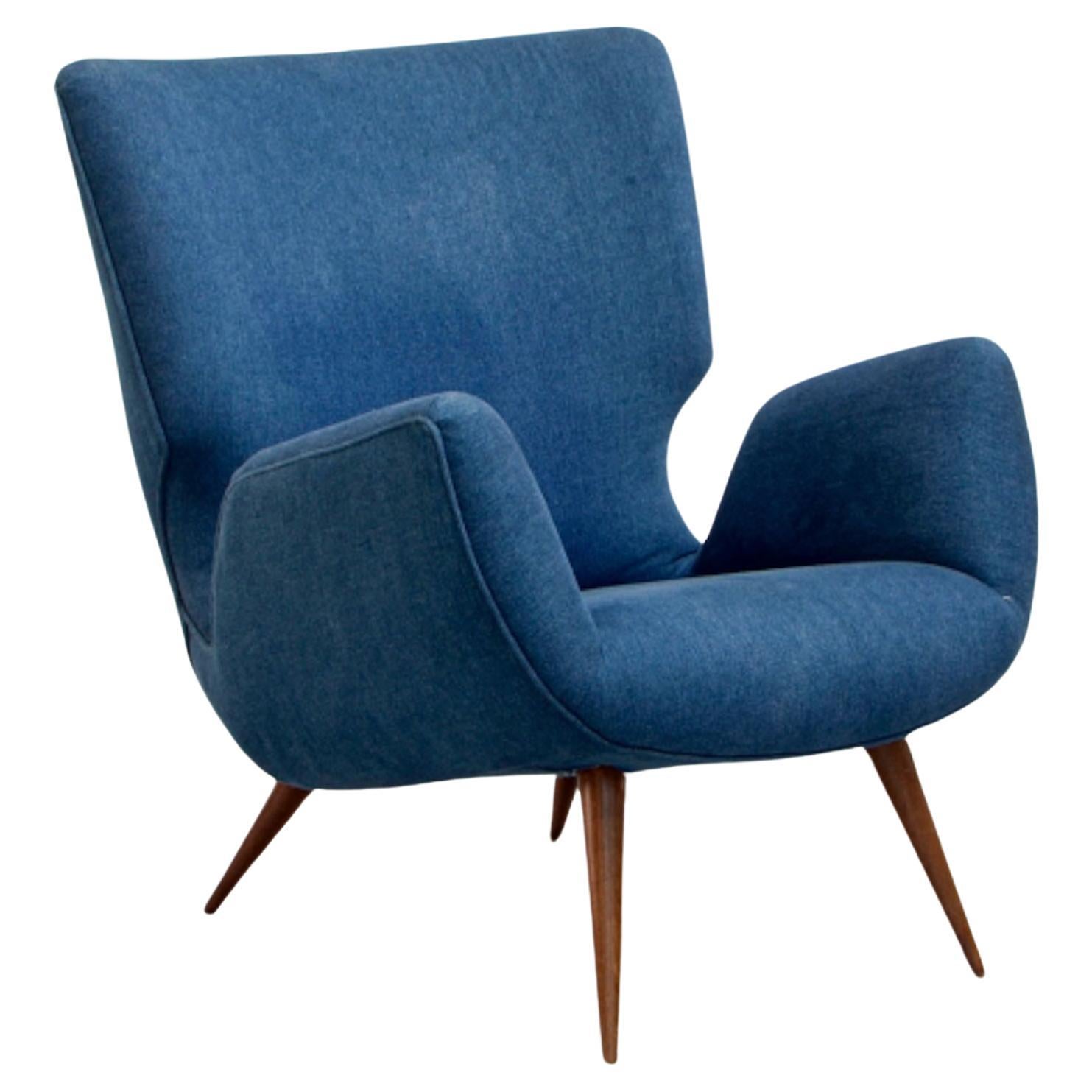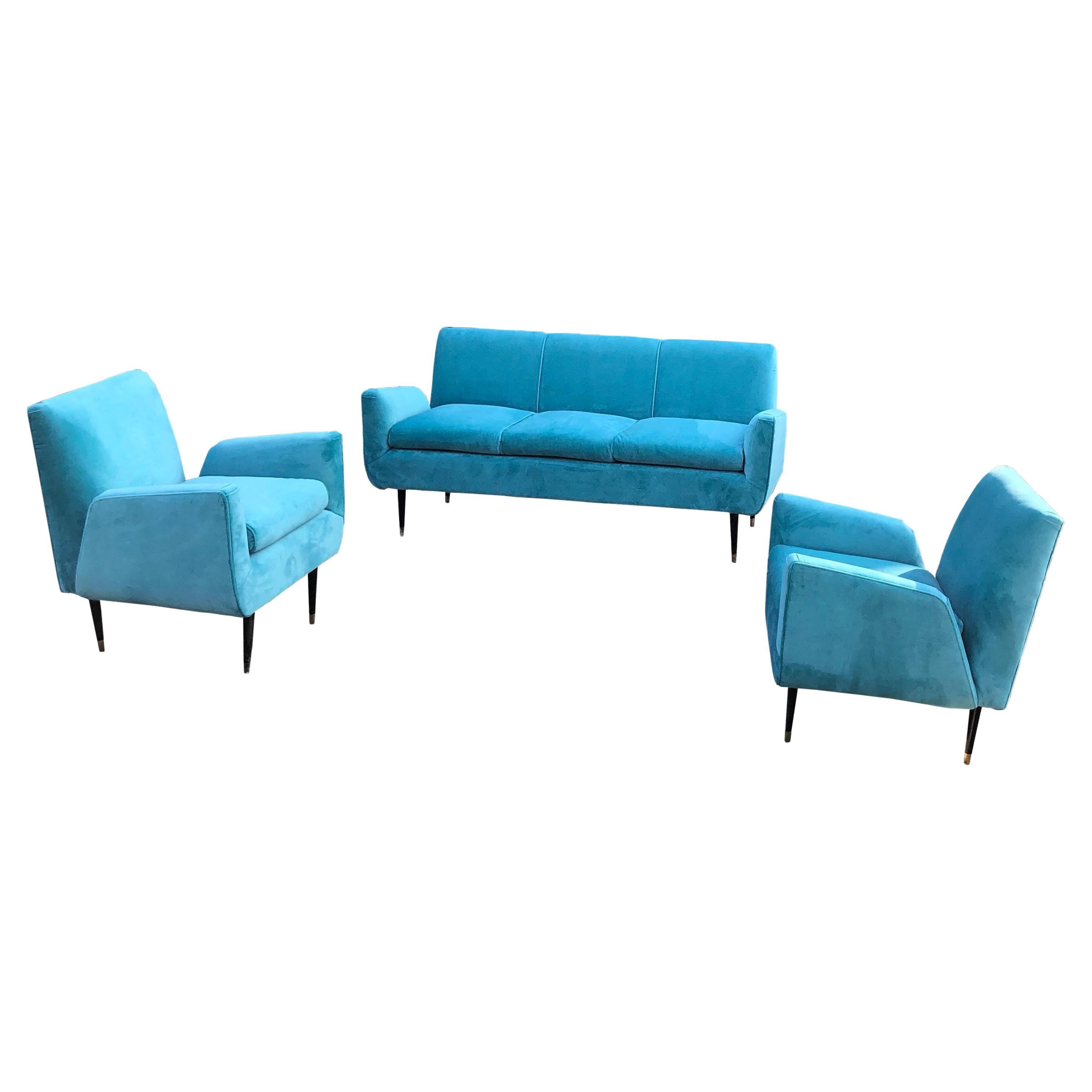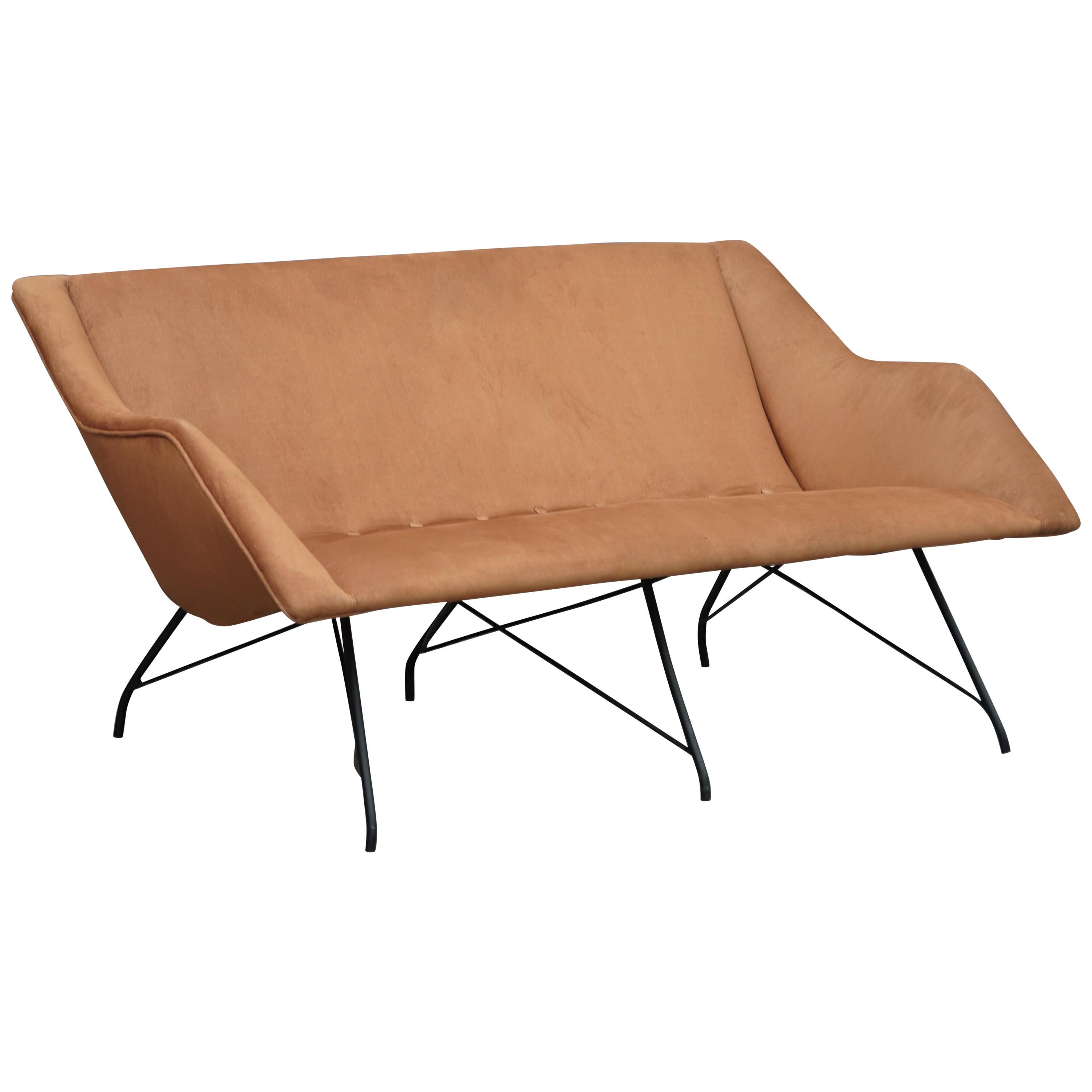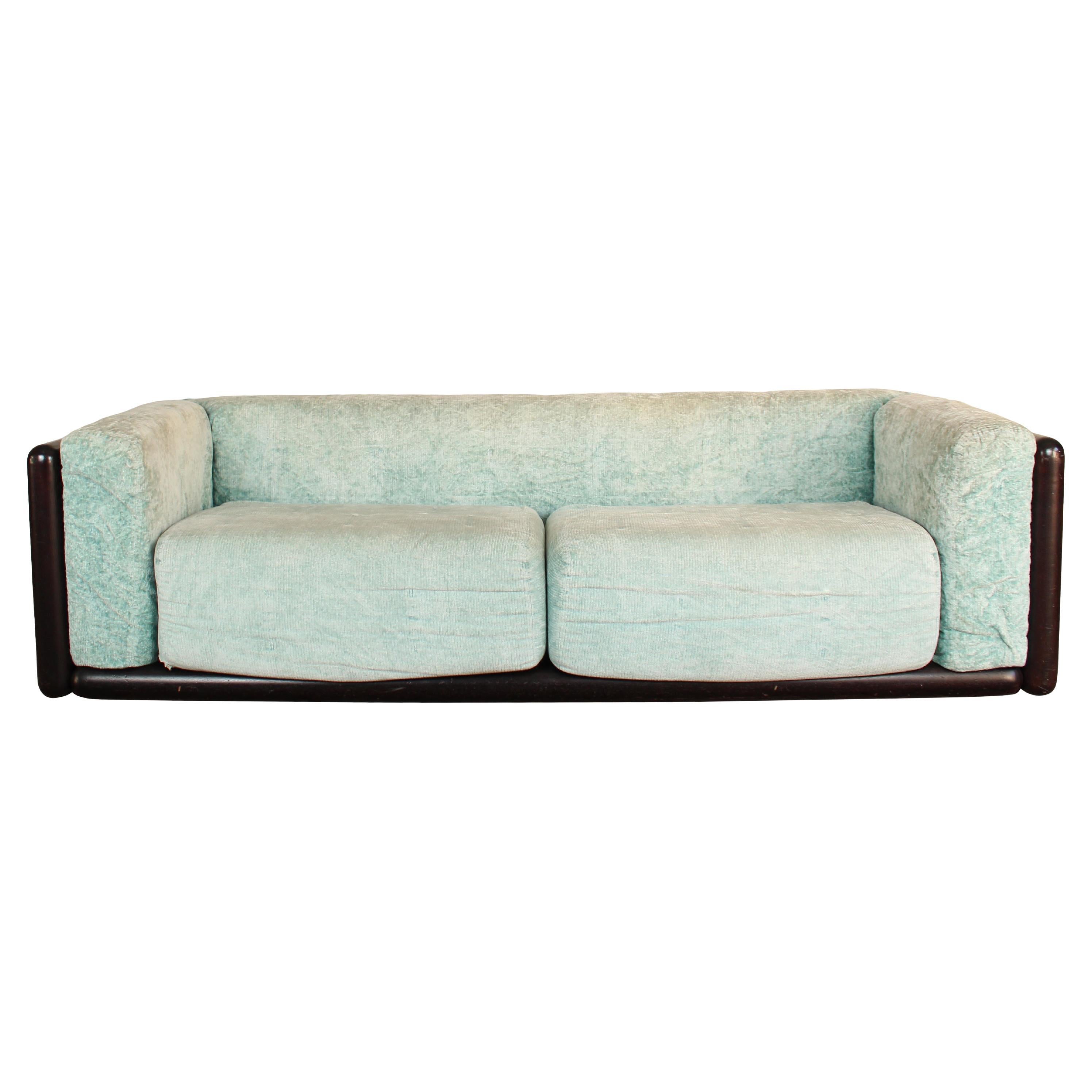Items Similar to Carlo Hauner. Sofa, c. 1950. Green cotton wood and velvet
Want more images or videos?
Request additional images or videos from the seller
1 of 5
Carlo Hauner. Sofa, c. 1950. Green cotton wood and velvet
About the Item
This three-seater sofa entirely covered in green cotton velvet is the synthesis of the Brazilian modern spirit.
Its slightly curved backrest gives sensuality to the piece in composition with sinuously cut armrests. This creates a geometry between form and counterform that an appropriate rhythm brings to the Carlo Hauner signature. The legs are conical (in pe palito) characteristic of the 1950s. The whole thing leads to a sofa where ergonomics and aesthetics are perfectly tuned.
Carlo Hauner :
Carlo Hauner (1927-1996) arrived in Brazil in 1948. He encountered the Brazilian modernist context of the mid-twentieth century, full of optimism due to the economic and social progress linked to the end of the Second World War. Of Italian origin, he settled in the cosmopolitan city of São Paulo and immediately founded the company "Moveis Artesanal" in 1950, in order to produce modern furniture and meet the demand of architects such as Lina Bo Bardi and Gregori Warchavchik.
The new techniques and materials brought about by modernization and the new modern architecture created in the spirit of innovation inherent in the modernist ideology prompted the creation of new furniture to integrate this new atmosphere.
- Creator:Carlo Hauner (Designer)
- Dimensions:Height: 33.47 in (85 cm)Width: 66.93 in (170 cm)Depth: 30.32 in (77 cm)Seat Height: 18.51 in (47 cm)
- Style:Mid-Century Modern (Of the Period)
- Materials and Techniques:
- Place of Origin:
- Period:
- Date of Manufacture:c. 1950
- Condition:Refinished. Reupholstered. Wear consistent with age and use.
- Seller Location:PARIS, FR
- Reference Number:1stDibs: LU6408239074792
About the Seller
No Reviews Yet
Vetted Seller
These experienced sellers undergo a comprehensive evaluation by our team of in-house experts.
Established in 2021
1stDibs seller since 2022
12 sales on 1stDibs
Typical response time: <1 hour
- ShippingRetrieving quote...Ships From: Saint-Ouen, France
- Return PolicyThis item cannot be returned.
More From This SellerView All
- Carlo Hauner, Armchair, 1950's, Caviuna Wood and Blue CottonBy Carlo HaunerLocated in PARIS, FRA typical piece of Carlo Hauner's design from the 1950s, this armchair rests on four conical legs, known in Brazilian as "Pè palito". The wide, curved backrest gives it depth while t...Category
Mid-20th Century Brazilian Mid-Century Modern Armchairs
MaterialsTextile, Wood
- Carlo Hauner Headboard, c. 1950 Forma EditionBy Carlo Hauner, FormaLocated in PARIS, FRMade of Caviuna wood, with a matching veneer and a delicate cane, this piece combines the robustness of the wood with the delicacy of the cane. The generous dimensions of 82 x 257 x ...Category
Mid-20th Century Brazilian Mid-Century Modern Daybeds
MaterialsStraw, Laminate, Hardwood
- Carlo Hauner. Suite of 4 Rattan chairs, c. 1950. Metal and rattanBy Carlo HaunerLocated in PARIS, FRThe suite of 4 rattan chairs designed by Carlo Hauner, dating from about 1950, is a superb example of timeless design. Made from rattan and metal, these chairs combine elegance and d...Category
Mid-20th Century Brazilian Mid-Century Modern Chairs
MaterialsMetal
- Carlo Hauner. Round dining table with glass, c. 1950By Carlo HaunerLocated in PARIS, FRThe Carlo Hauner table is an emblematic design piece dating from the 1950s. It has an elegant and timeless aesthetic. This round dining table is designed with a blend of high-quality...Category
Mid-20th Century Brazilian Mid-Century Modern Dining Room Tables
MaterialsIron
- Carlo Hauner. Magazine holder, c. 1950 Black lacquered metal base.By Carlo HaunerLocated in PARIS, FRRare magazine rack designed by Carlo Hauner, with a black lacquered metal base, a hammered and lacquered copper structure, as well as a metal handle, dating from about 1950. The mag...Category
Mid-20th Century Brazilian Mid-Century Modern Magazine Racks and Stands
MaterialsMetal, Copper
- Giuseppe Scapinelli. Sofa in Caviuna's wood, 4 seats, c. 1950By Giuseppe ScapinelliLocated in PARIS, FRFour-seater sofa in solid Caviuna wood, recently redone tapestry in unbleached linen. The finesse and sinuousness of the wooden round section legs and armrests marks the elegance of ...Category
Mid-20th Century Brazilian Mid-Century Modern Sofas
MaterialsUpholstery, Hardwood
You May Also Like
- Forma S.a Rare Sofa by Carlo Hauner and Martin Eisler, Ca 1954 Midcentury BrazilBy Martin Eisler, Carlo Hauner and Martin Eisler, Carlo HaunerLocated in New York, NYThis rare sofa was designed in 1955 and produced by Forma, a company directed by Carlo Hauner (1927- 1996) and Martin Eisler (1913- 1977). This piece is an icon and illustrates some ...Category
Vintage 1950s Brazilian Mid-Century Modern Sofas
MaterialsLeather, Rosewood
- Martin Eisler & Carlo Hauner Modern Sofa & Armchairs Lounge Set, 1950sBy Carlo Hauner and Martin Eisler, FormaLocated in Whitstable, GBCarlo Hauner & Martin Eisler midcentury sofa and armchairs; 1950s Sofa designed for their manufacturing company, Forma around 1955. This model is an icon of Brazilian midcentury des...Category
Mid-20th Century Brazilian Mid-Century Modern Sofas
MaterialsVelvet, Hardwood
- "Concha" Sofa by Carlo Hauner and Martin Eisler, Modern Brazilian Design, 1950sBy Carlo Hauner and Martin EislerLocated in New York, NYDesigned by Carlo Hauner and Martin Eisler, modern Brazilian sofa, iron, and velvet. Brazil, circa 1950s. Shell or "Concha" sofa is made of iron and recently reupholstered in yellow velvet by the experienced craftsmen in our team. The upholstery was chosen considering the contemporary proposal of the piece. The sofa features a comfortable seat, clean design, and freedom of user movements and is constructed in a frame with metal rods elegantly positioned to give strength to the piece, a common trait of designers. The buttons velvet coated between seat and backs were used, by the designers, for an excellent velvet finish, and the restoration proposal was to maintain them. Martin Eisler and Carlo Hauner were the primary designers for the iconic Brazilian furniture...Category
Vintage 1950s Brazilian Mid-Century Modern Sofas
MaterialsIron
- White Fabric Sofa by Martin Eisler and Carlo HaunerBy Carlo Hauner and Martin EislerLocated in Milan, ITMartin Eisler (Vienna, 1913 – Brasile, 1977) & Carlo Hauner (Brescia, 1927 – Isola di Salina, 1997) European by birth and Brazilian by adoption, Martin Eisler and Carlo Hauner began...Category
Vintage 1950s Brazilian Mid-Century Modern Sofas
MaterialsStainless Steel
- Carlo Scarpa Iroko Wood and Green Velvet Cornaro Sofa for Studio Simon, 1974By Studio Simon, Carlo ScarpaLocated in Vicenza, ITCornaro two-seater sofa, designed by Carlo Scarpa and manufactured by Studio Simon in 1974. Made of Iroko wood, foam, and azure chenille velvet. Excellent vintage condition. Born in Venice on June 2nd, 1906, Carlo Scarpa began working very early. Only a year after he had first qualified as an architect in 1926, he began working for the Murano glassmakers Cappellin & Co. in a consultative capacity; from 1927, he began to experiment with the Murano glass, and this research not only gave him excellent results here but would also inform his progress for many years to come. Between 1935 and 1937, as he entered his thirties, Carlo Scarpa accepted his first important commission, the renovation of Venice’s Cà Foscari. He adapted the spaces of this stately University building which stands on the banks of the Grand Canal, creating rooms for the Dean’s offices and a new hall for academic ceremonies; Mario Sironi and Mario De Luigi were charged with doing the restoration work on the frescos. After 1945, Carlo Scarpa was constantly busy with new commissions, including various furnishings and designs for the renovation of Venice’s Hotel Bauer and designing a tall building in Padua and a residential area in Feltre, all worth mentioning. One of his key works, despite its relatively modest diminished proportions, was the first of many works which were to follow in the nineteen fifties: the [bookshop known as the] Padiglione del Libro, which stands in Venice’s Giardini di Castello and shows clearly Scarpa’s passion for the works of Frank Lloyd Wright. In the years which were to follow, after he had met the American architect, Scarpa repeated similar experiments on other occasions, as can be seen, in particular, in the sketches he drew up in 1953 for villa Zoppas in Conegliano, which show some of his most promising work. However, this work unfortunately never came to fruition. Carlo Scarpa later created three museum layouts to prove pivotal in how twentieth-century museums were set up from then on. Between 1955 and 1957, he completed extension work on Treviso’s Gipsoteca Canoviana [the museum that houses Canova’s sculptures] in Possagno, taking a similar experimental approach to the one he used for the Venezuelan Pavilion at [Venice’s] Giardini di Castello which he was building at the same time (1954-56). In Possagno Carlo Scarpa was to create one of his most incredible ever works, which inevitably bears comparison with two other museum layouts that he was working on over the same period, those of the Galleria Nazionale di Sicilia, housed in the Palazzo Abatellis in Palermo (1953-55) and at the Castelvecchio in Verona (1957- 1974), all of which were highly acclaimed, adding to his growing fame. Two other buildings, which are beautifully arranged in spatial terms, can be added to this long list of key works that were started and, in some cases, even completed during the nineteen fifties. After winning the Olivetti Award for architecture in 1956, Scarpa began work in Venice’s Piazza San Marco on an area destined to house products made by the Industrial manufacturers Ivrea. Over the same period (1959-1963), he also worked on renovating and restoring the gardens and ground floor of the Fondazione Querini Stampalia in Venice, which many consider one of his greatest works. While he worked on-site at the Fondazione Querini Stampalia, Carlo Scarpa also began building a villa in Udine for the Veritti family. To shed some light on how much his work evolved over the years, it may be useful to compare this work with that of his very last building, villa Ottolenghi Bardolino, which was near completion at the time of his sudden death in 1978. Upon completion of villa Veritti over the next ten years, without ever letting up on his work on renovation and layouts, Scarpa accepted some highly challenging commissions which were to make the most of his formal skills, working on the Carlo Felice Theatre in Genoa as well as another theatre in Vicenza. Towards the end of this decade, in 1969, Rina Brion commissioned Carlo Scarpa to build the Brion Mausoleum in San Vito d’Altivole (Treviso), a piece he continued to work on right up until the moment of his death. Nevertheless, even though he was totally absorbed by work on this mausoleum, plenty of other episodes can offer some insight into the final years of his career. As work on the San Vito d’Altivole Mausoleum began to lessen in 1973, Carlo Scarpa started building the new headquarters for the Banca Popolare di Verona. He drew up plans that were surprisingly different from the work he carried out simultaneously on the villa Ottolenghi. However, the plans Carlo Scarpa drew up, at different times, for a monument in Brescia’s Piazza della Loggia commemorating victims of the terrorist attack on May 28th, 1974, make a sharp contrast to the work he carried out in Verona, almost as if there is a certain hesitation after so many mannered excesses. The same Pietas that informs his designs for the Piazza Della Loggia can also be seen in the presence of the water that flows through the Brion Mausoleum, almost as if to give a concrete manifestation of pity in this twentieth-century work of art. Carlo Scarpa has put together a highly sophisticated collection of structures occupying the mausoleum’s L-shaped space stretching across both sides of the old San Vito d’Altivole cemetery. A myriad of different forms and an equally large number of different pieces, all of which are separate and yet inextricably linked to form a chain that seems to offer no promise of continuity, arising out of these are those whose only justification for being there is to bear the warning “si vis vitam, para mortem,” [if you wish to experience life prepare for death] as if to tell a tale that suggests the circle of time, joining together the commemoration of the dead with a celebration of life. At the entrance of the Brion Mausoleum stand the “propylaea,” followed by a cloister that ends by a small chapel, with an arcosolium bearing the family sarcophagi, the central pavilion, held in place on broken cast iron supports, stands over a mirror-shaped stretch of water and occupies one end of the family’s burial space. The musical sound of the walkways, teamed with the luminosity of these harmoniously blended spaces, shows how, in keeping with his strong sense of vision, Carlo Scarpa could make the most of all his many skills to come up with this truly magnificent space. As well as an outstanding commitment to architectural work, with the many projects we have already seen punctuating his career, Carlo Scarpa also made many equally important forays into the world of applied arts. Between 1926 and 1931, he worked for the Murano glassmakers Cappellin, later taking what he had learned with him when he went to work for the glassmakers Venini from 1933 until the 1950s. The story of how he came to work on furniture design is different, however, and began with the furniture he designed to replace lost furnishings during his renovation of Cà Foscari. The later mass-produced furniture started differently, given that many pieces were originally one-off designs “made to measure.” Industrial manufacturing using these designs as prototypes came into being thanks to the continuity afforded him by Dino Gavina, who, as well as this, also invited Carlo Scarpa to become president of the company Gavina SpA, later to become SIMON, a company Gavina founded eight years on, in partnership with Maria Simoncini (whose own name accounts for the choice of company name). Carlo Scarpa and Gavina forged a strong bond in 1968 as they began to put various models of his into production for Simon, such as the “Doge” table, which also formed the basis for the “Sarpi” and “Florian” tables. In the early seventies, other tables that followed included “Valmarana,” “Quatour,” and “Orseolo.” While in 1974, they added a couch and armchair, “Cornaro,” to the collection and the “Toledo” bed...Category
Vintage 1970s Italian Mid-Century Modern Living Room Sets
MaterialsVelvet, Foam, Chenille, Wood
- Italian Sofa in Green Velvet and WoodLocated in Milano, ITLet's immerse ourselves in the enchanted atmospheres of the 1950s, a golden era for Italian design, through our magnificent green velvet sofa. This piece is much more than a mere fur...Category
Vintage 1950s Italian Mid-Century Modern Sofas
MaterialsVelvet, Wood
Recently Viewed
View AllMore Ways To Browse
Studio Mut
Habitat Moderno
Camaleonda Blue
Perceval Knife
Walter Knoll Together
Camaleonda Pink
Gray And White Sofa
Velvet Section
Italian Modern Leather Sofa Black
B Italia Sofa
Bluer Sofa Set
Curl Sofa
Little Tree Antiques
Ligne Roset Togo Blue Velvet
Cognac Leather Chesterfield Sofa
Couch Bb
White Cloud Couch
Long Dunbar Sofa





